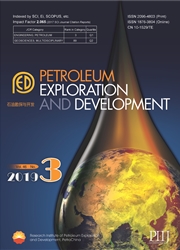Logging response characteristics and formation process of flushed zone in the Orinoco heavy oil belt, Venezuela
作者:CHEN Heping,CHEN Hao,LI Changwen,WANG Yusheng,LI Jianping,HUANG Rui,TIAN Congcong,HOU Qiuyuan
摘要:The origins and logging responses of flushed zones in some blocks of Orinoco heavy oil belt, Venezuela are still unclear. To solve this issue, we examined the conventional logging, nuclear magnetic resonance logging, fluid viscosity, core analysis and oil field production data comprehensively to find out the logging responses and origins of the flushed zones. The results show that the main reason for the formation of flushed zone is surface water invasion, which leads to crude oil densification. The crude oil densification produces asphalt membrane(asphalt crust) which wraps up free water, causing special logging responses of the flushed zones. According to the different logging responses, we classified the flushed zones into two types and analyzed the formation processes of the two types of flushed zones. According to the characteristics of logging curves after water flush, we confirmed that the water flush began earlier than the reservoir accumulation.
发文机构:PetroChina Research Institute of Petroleum Exploration&Development International Division China National Oil and Gas Exploration and Development Corporation Ltd.
关键词:flushedzoneasphaltcrustcrudeoilthickeningfreshwaterleachingfoamoilflowOrinocoheavyoilbelt
分类号: TE151[石油与天然气工程—油气勘探]
- Enrichment and exploration of deep lacustrine shale oil in the first member of Cretaceous Qingshankou Formation, southern Songliao Basin, NE China
- A coupled model of temperature and pressure based on hydration kinetics during well cementing in deep water
- Scaled physical experiments on drainage mechanisms of solvent-expanded SAGD in super-heavy oil reservoirs
- Diagenetic evolution and formation mechanisms of middle to deep clastic reservoirs in the Nanpu sag, Bohai Bay Basin, East China
- Artificial neural network based production forecasting for a hydrocarbon reservoir under water injection
- An evaluation method of volume fracturing effects for vertical wells in low permeability reservoirs
- Main flow channel index in porous sand reservoirs and its application
- Effects of vugs on resistivity of vuggy carbonate reservoirs
- Pore-throat structure characteristics and its impact on the porosity and permeability relationship of Carboniferous carbonate reservoirs in eastern edge of Pre-Caspian Basin
- Structural failure mechanism and strengthening method of fracture plugging zone for lost circulation control in deep naturally fractured reservoirs


